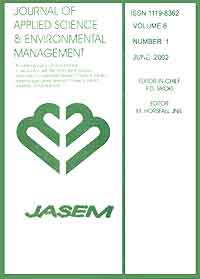
|
Journal of Applied Sciences and Environmental Management
World Bank assisted National Agricultural Research Project (NARP) - University of Port Harcourt
ISSN: 1119-8362
Vol. 22, No. 3, 2018, pp. 432-438
|
 Bioline Code: ja18076
Bioline Code: ja18076
Full paper language: English
Document type: Research Article
Document available free of charge
|
|
|
Journal of Applied Sciences and Environmental Management, Vol. 22, No. 3, 2018, pp. 432-438
| en |
Removal of Pb and Zn from Soil using cowpea ( Vigna unguiculata  ) and maize ( Zea mays ) and maize ( Zea mays  ) Plants ) Plants
OLADELE, EO; ADEWUMI, OO; TAIWO, IA & ODEIGAH, PGC
Abstract
This study investigated the potential of cowpea (Vigna unguiculata) and maize (Zea mays) plants
to remove Pb and Zn from soil. The crops were exposed to three concentrations (100, 150 and 200 mgkg-1) of each
metal salts during the study. When the plants were treated with lead nitrate at a concentration of 150 mgkg-1, the
amount and percentage of Pb removed and accumulated within plants’ tissues were 65.68 m mgkg-1g/kg (44.79%)
and 78.93 mgkg-1 (53.0%) for cowpea and maize with bioconcentration factors 0.80 and 0.78 respectively. However,
when the plants were assisted they had greater bioconcentration factors. Farmyard manure enhanced metal uptake by
cowpea and maize significantly than EDTA. Maize extracted more Pb into its roots and translocated to shoots when
assisted with EDTA than cowpea. Maize was able to translocate more Pb while cowpea translocated more Zn through
the vascular system, thereby acting as phytoextractors for the different metals respectively.
Keywords
Chelate; Translocation factor; Bioconcentration factor; Phytoextraction; Phytoremediation
|
| |
© Copyright 2018 - Oladele at el.
|
|
